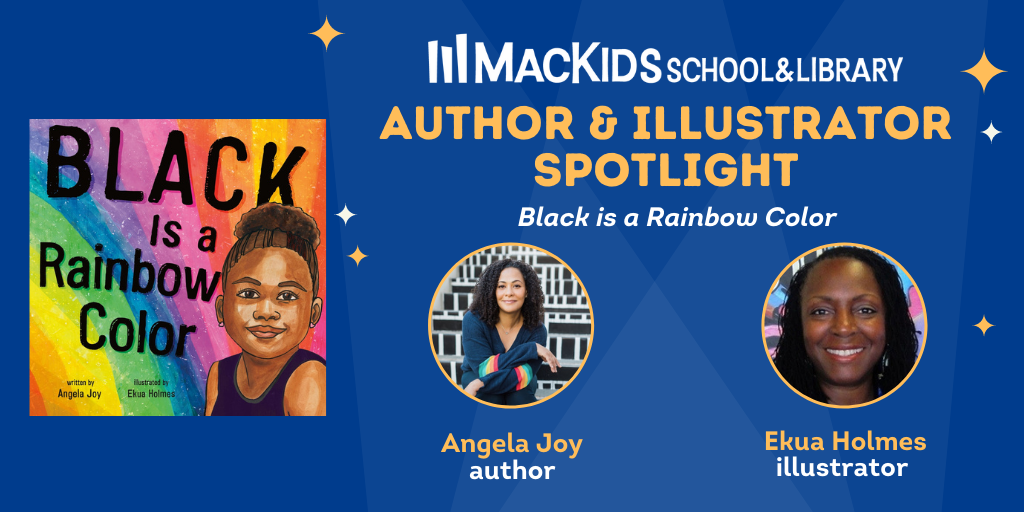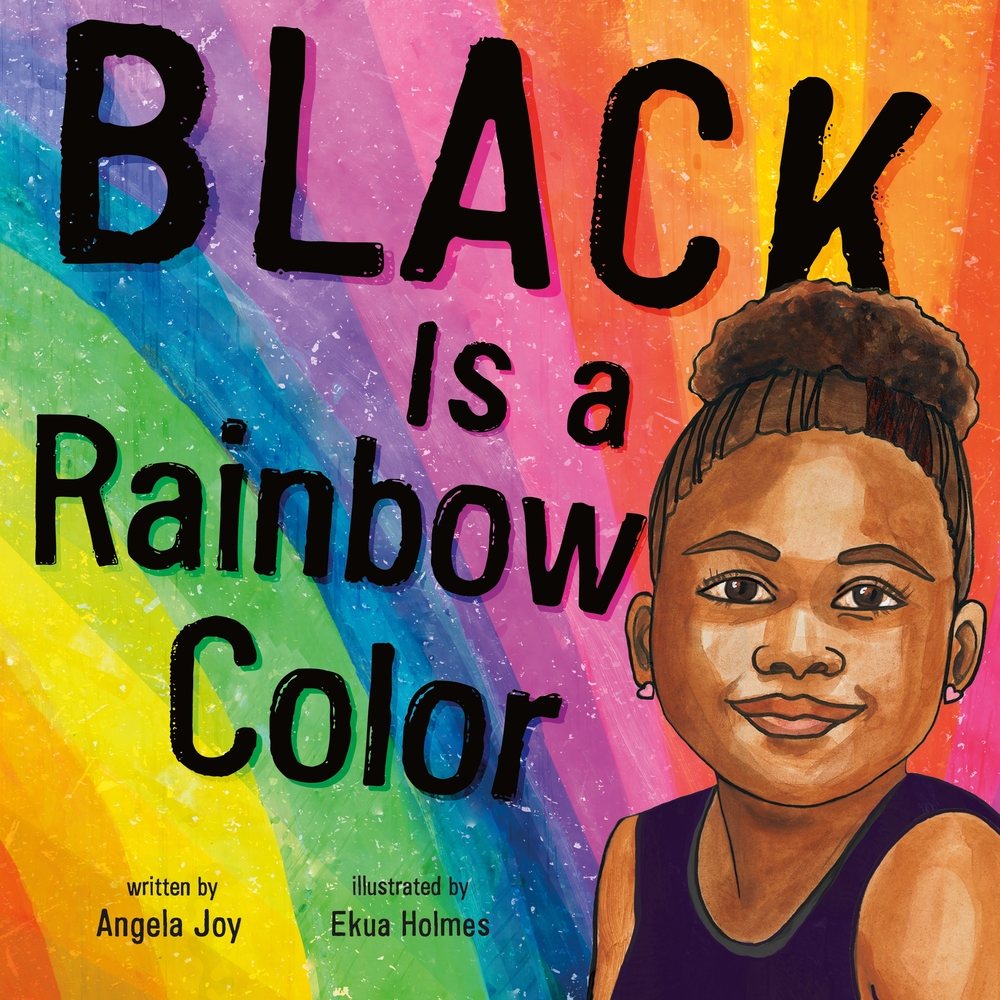
Meet the creators of the stunning picture book Black is a Rainbow Color, Angela Joy and Ekua Holmes! Angela and Ekua share more about their inspiration for this picture book, their most memorable teachers and librarians, their favorite childhood books, and more!
When describing Black is a Rainbow Color, what’s your elevator pitch?

Angela Joy: Black is a Rainbow Color is a picture book that bridges the gap between black as a literal color, and Black as an American culture. It’s a celebration of all things beautiful, positive, strong, and black.
Ekua Holmes: I love this book because it’s the kind of scenario Black parents find themselves in and aren’t necessarily prepared for. Angela Joys text prepares us! A mother is getting ready to give her children a Black History lesson when her daughter gives her a quizzical look and says, “But mommy we are not Black, we are brown!” At that moment Mom realizes she has not set the “Black” foundation of history and culture with her children. The poem that follows beautifully outlines the tapestry of black as a color, Black as a culture, Black as a people.

What inspired you to write/illustrate Black is a Rainbow Color?
Angela: I was raised in the Black community. While my mother is white, she steeped me in a highly integrated “village” where I was never anything other than beautifully Black. My children did not have this benefit. Living in the ‘burbs, their precious preschool minds didn’t learn by osmosis (as I did) that Black is a color as well as the culture to which they belong. In the process of bridging this gap with them, I learned that other parents—including white parents—were navigating the same waters. Thus, Black is a Rainbow Color was born.
Ekua: I wanted to base my illustrations on a coloring books. A coloring book, common to all children, features black line drawings that allow them to collaborate by deciding what colors go where. Will the birds be blue or purple or will the person be black or “flesh.” Children are familiar with making these choices as they go about their creative work. I thought that was a great context for them to consider the power of the color “Black.” Secondly, I thought about including a reference to stained glass, an artform that requires light to be truly appreciated. Like the history of Black Americans, once we shine a light on the story, we see its great complexity, depth, detail and beauty.
Tell us about a librarian or educator who made an impact on you.
Angela: Oh, man! My 7th/8th grade English, Spanish, and Sign Language teacher, Ms. Sommers, had a tremendous impact on me. I can quote Shakespeare because of her. I can sign “Stop In The Name of Love” by the Supremes because of her. I can speak (and swear) in Spanish with a perfect accent because of her (she said, “If you’re going to say it, say it properly”). But more than that, at a time in my life when I could have gotten seriously lost, Ms. Sommers took a personal interest in me. She helped to reorient me; showing me potential I wasn’t sure I had. We are very close to this day—and 30 years later, I still call her “Ms. Sommers!”
Ekua: My Aunt, Ms. Barbara Clarke Elam was a librarian. In her time, as a Black librarian, she was a rare creature. A Simmons graduate in Library Science, she went on to train School Librarians in Boston. Many express their indebtedness to her for opening up the world of literature and education to them. She taught by her actions that reading was fundamental to a rich inner life. It was her love for sharing books and innumerable trips with her and my cousins to the Egleston Branch of the Boston Public library in Roxbury that introduced me to art, found on the pages of books like Curious George, Make Way for Ducklings and Madeline and the Bad Hat. The images in those books intrigued me as a child and set my feet on the path to becoming a visual artist. Every Holiday season, under the tree, there was a book from her, selected just for me and just right for me.
Is there a book that you wish you wrote/illustrated?
Angela: It’s funny to say that I wish I wrote Brown Girl Dreaming, because only Jacqueline Woodson could write that story—her story. But I wish that I could express my childhood thoughts, fears, experiences, and dreams as honestly and as beautifully as she has done with Brown Girl Dreaming. The grace of that book takes my breath away.
Ekua: It’s hard to imagine illustrating a book that’s already been done but I have loved all of my projects to date and look forward to the new manuscript that will call my name.
What is the first step in your creative process?
Angela: My first step in the creative process is research. I have to know my subject matter inside and out before I can put pen to page. And when I feel “blocked;” when the words don’t seem to come, I research more until I can’t contain the ideas. That’s when the writing begins.
Ekua: Reading and rereading the manuscript. Reading it out loud. Recently I’ve begun taping myself and listening to myself reading the manuscript. Makes for a great before bed activity with a nice cup of tea. Next I think about colors and the mood I want to set for the book. Then on research: Google and the Public Library.
What was your favorite book when you were 10 years old?
Angela: Honestly, my first love was music. When I was 10, I spent more time in front of the mirror singing Whitney Houston than I did reading. However, I clearly recall the heartache of Where the Red Fern Grows, and the giggles that came with Where the Sidewalk Ends. That Sarah Cynthia Sylvia Stout was hilarious to me!
Ekua: I can only remember what was NOT my favorite – Canterbury Tales!! But I was in love with Greek and Roman Mythology . . .
ABOUT THE AUTHORS
ABOUT THE AUTHORS:
Angela Joy was born and raised in Minneapolis. Before graduating Summa Cum Laude from the University of Minnesota, Angela attended New York University and Spelman College. Angela then traveled as a background vocalist, also working in television and movie soundtracks. She lives in southern California with her family. Black Is a Rainbow Color is her first book.
Ekua Holmes is a native of Roxbury, MA, a graduate of the Massachusetts College of Art and Design, and a recipient of the 2013 NAACP Image Award, a Brother Thomas Fellowship, and a 5-year appointment to the Boston Art Commission. Her picture books include the Caldecott Honor book Voice of Freedom and the Coretta Scott King Award winners Out of Wonder and The Stuff of Stars. Holmes serves as Assistant Director of MassArt’s Center for Art and Community Partnerships, and manages sparc! the ArtMobile, the institution’s vehicle for community outreach.
ABOUT THE BOOK:
Black is a Rainbow Color by Angela Joy; illustrated by Ekua Holmes
Ages 4-8
From the wheels of a bicycle to the robe on Thurgood Marshall’s back, Black surrounds our lives. It is a color to simply describe some of our favorite things, but it also evokes a deeper sentiment about the incredible people who helped change the world and a community that continues to grow and thrive.
Stunningly illustrated by Caldecott Honoree and Coretta Scott King Award winner Ekua Holmes, Black Is a Rainbow Color is a sweeping celebration told through debut author Angela Joy’s rhythmically captivating and unforgettable words.
Praise for Black is a Rainbow Color:
★“Both a beautiful celebration of black culture and an excellent first black history book for young children.” —Kirkus Reviews, starred review
★“A treasure trove of positivity, strength, and pride for anyone seeking to uplift and educate young people.” —Horn Book, starred review
★“A beautifully told and illustrated celebration of African American people and ethnology, Black Is a Rainbow Color thoughtfully explores what the Black experience means to a child . . . A must-have for children’s collections.” —Booklist, starred review



